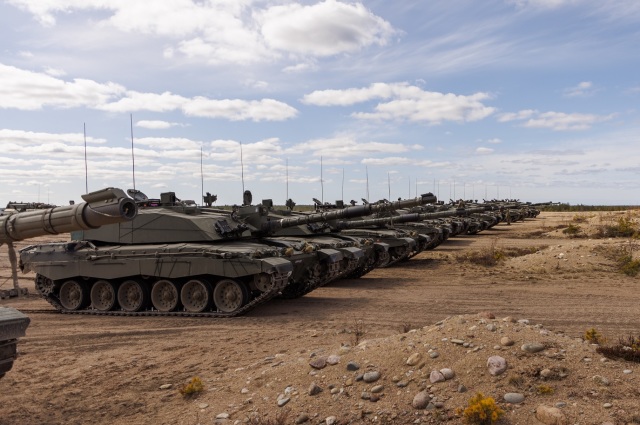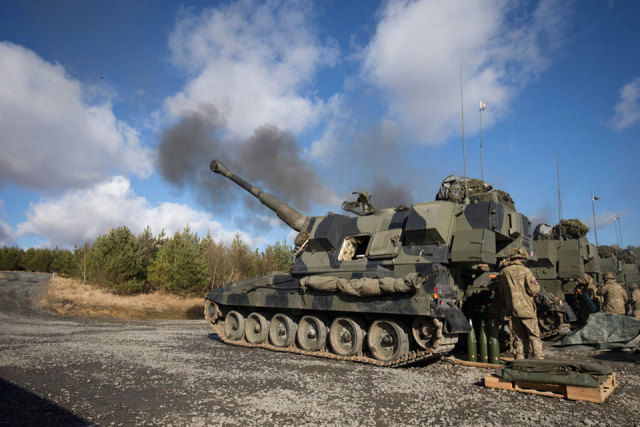On January 14, 2023, British Prime Minister Rishi Sunak officially announced the decision to transfer 14 Challenger 2 main tanks and "about 30" 155-mm/39 AS90 self-propelled howitzers to Ukraine from the presence of the British armed forces. It is stated that a squadron (company) of 14 Challenger 2 tanks will be sent to Ukraine "in the coming weeks", and that already "in the coming days, the UK will begin training the armed forces of Ukraine in the use of tanks and artillery guns."

Challenger 2 tanks from Her Majesty's Royal Hussars (Queen's Royal Hussars) of the British Army at the Niinisalo training ground in Finland during the joint exercise Exercise Arrow, May 2022 (c) British ArmyIn a statement, the British Prime Minister said:
"The Prime Minister intends to accelerate the UK's diplomatic and military support for Ukraine in the coming weeks in order to push Russia further back and ensure lasting peace.
There will be a surge in UK diplomatic activity around the world this week after the Prime Minister instructed key ministers to step up international action as the first anniversary of the full-scale invasion of Ukraine at the end of February approaches.
The Prime Minister has already committed to match or surpass the UK's defense support for Ukraine in 2023, and this week he instructed ministers and officials to ensure maximum activity across the entire spectrum of our support.
British defense and security officials believe that a window has opened in which Russia is lagging behind due to problems with resupply and falling morale. Therefore, the Prime Minister calls on the allies to deploy the planned support for 2023 as soon as possible in order to achieve maximum effect.
Sending Challenger 2 tanks to Ukraine is the beginning of a change in the vector of support from the UK. A squadron of 14 tanks will be sent to this country in the coming weeks after the Prime Minister informed President Zelensky that the UK would provide additional support to Ukraine in a ground war. They are expected to be followed by about 30 large self-propelled guns AS90, with a crew of five people. The Defence Secretary will outline further details of this support in the House of Commons on Monday [January 16].
In the coming days, the UK will begin training the armed forces of Ukraine in the use of tanks and artillery pieces as part of a broader British effort, during which thousands of Ukrainian servicemen have been trained in the UK over the past six months.
The Prime Minister instructed the Defense Minister to bring together European allies to ensure the most strategic and coordinated surge of global military support. This week, the Defense Minister will travel to Estonia and Germany to work together with NATO allies and other international partners.
Meanwhile, later this week, the Foreign Secretary will travel to the United States to discuss how the UK and the US can use our position as leading supporters of Ukraine to step up further international action.
He will also travel to Canada, another of Ukraine's staunchest supporters, to discuss closer coordination on international sanctions and our coordinated efforts to strengthen our support for Ukraine.
A Downing Street spokesman said:
As the people of Ukraine approach their second year of life under ruthless Russian bombing, the Prime Minister has dedicated himself to making sure that Ukraine wins this war.
Together with his closest military advisers, he analyzed the military situation, studied the strategic impact of supporting the UK and identified a window in which, in his opinion, the UK and its allies can exert maximum influence.
The Prime Minister makes it clear that a long and positional war only serves Russia's goals. That's why he and his ministers will be negotiating with our allies around the world in the coming days and weeks to increase pressure on Putin and ensure a better future for Ukraine.
On the eve of the anniversary of the invasion, the Prime Minister will seek to demonstrate the strength of the UK as an international catalyst with influence on NATO, the G7, the Joint Expeditionary Force and other structures.
He will work with partners to put Ukraine in the strongest possible position from which it could enter into future peace negotiations from strong military, economic and diplomatic positions to ensure a lasting and sustainable peace."
From the bmpd side, we point out that initially, from 1994 to 2002, 386 Challenger 2 tanks and 22 training tanks were delivered to the British army. All of them were produced at the tank factories in Elzwick and Leeds, owned at that time by Alvis (in 2004, together with the enterprises, it came under the control of BAE Systems Corporation). Another 38 tanks in 1998-2001 were manufactured for Oman. According to the Strategic Defense and Security Review (SDSR-2010) published in 2010 by the British government, the number of Challenger 2 combat tanks in the British army was reduced to 225, while it was planned to keep them in service until 2035.
In March 2021, in a new official defense and security review published by the British Ministry of Defense, the Defense Command Paper, it was announced that 77 of the 225 Challenger 2 tanks remaining in the British army would be decommissioned, and the remaining 148 would be upgraded to the Challenger 3 variant, which should remain in service at least until 2040. The contract for upgrading 148 tanks to the Challenger 3 level was signed in May 2021 with the British joint venture Rheinmetall BAE Systems Land (RBSL), formed by the German group Rgeinmetall and BAE Systems, with delivery from 2027 to 2030.
Therefore, it can be estimated that the UK has some resource for the transfer of Challenger 2 tanks to Ukraine, and, most likely, it will not be limited to one company in the end.
As for the 155 mm/ 39 AS90 self-propelled howitzers, the British Army received 179 of these systems in 1992-1995, manufactured by the then company Vickers Shipbuilding and Engineering (VSEL, since 1999 its capacities have been part of BAE Systems). By 2015, the number of AS90 combat self-propelled guns in the British Army was only 115 units, and in the same year, the decisions taken were reduced to 89. Their decommissioning was planned in 2030-2032.
Recall that the issue of transferring the AS90 to Ukraine was discussed in the spring of 2022, but then British Defense Minister Ben Hodges rejected these proposals, publicly calling the AS90 ACS "cumbersome and outdated." It should be noted that the British media has repeatedly reported problems with the technical readiness of the AS90, including an acute shortage of spare parts for them, to the point that in 2021 some sources estimated the number of combat-ready self-propelled guns of the British army "from 10 to less than 20" out of the regular 89.
A number of British media in recent days have also reported on the alleged intention of the UK to transfer four Boeing AH-64E Apache combat helicopters with Hellfire missiles to Ukraine, but on January 15 these reports were officially denied by the British government.

155 mm/39 self-propelled howitzer AS90 of the British Army at the firing range in Otterburn (North Yorkshire), 2015 (c) Simon Longworth / British Army
